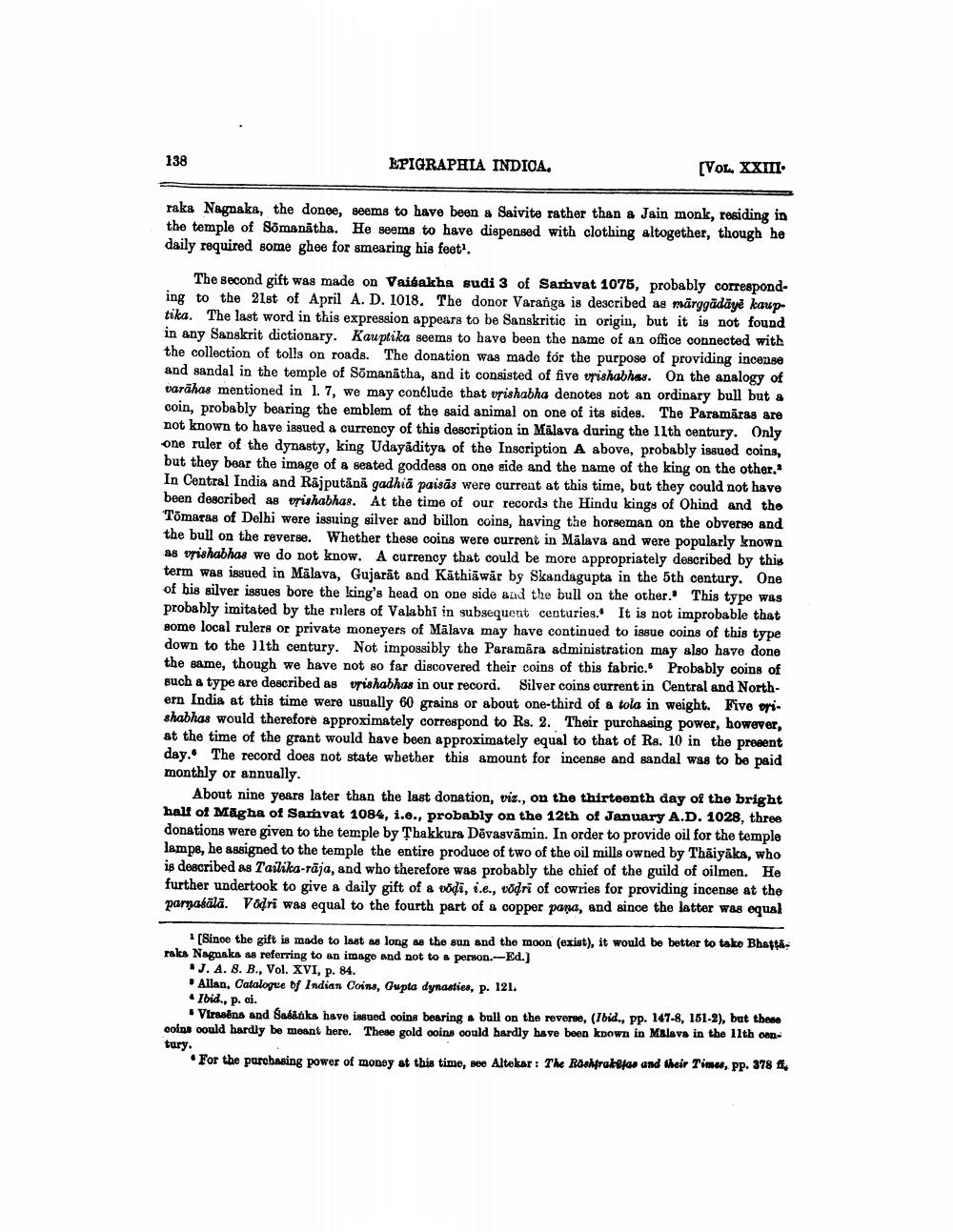________________
138
EPIGRAPHIA INDICA.
[VOL. XXIII.
raka Nagnaka, the donee, seems to have been a Saivite rather than a Jain monk, residing in the temple of Somanatha. He seems to have dispensed with clothing altogether, though he daily required some ghee for smearing his feet1.
The second gift was made on Vaisakha sudi 3 of Samvat 1075, probably corresponding to the 21st of April A. D. 1018. The donor Varanga is described as märggädäyė kauptika. The last word in this expression appears to be Sanskritic in origin, but it is not found in any Sanskrit dictionary. Kauptika seems to have been the name of an office connected with the collection of tolls on roads. The donation was made for the purpose of providing incense and sandal in the temple of Somanatha, and it consisted of five vrishabhas. On the analogy of varahas mentioned in 1. 7, we may conélude that vrishabha denotes not an ordinary bull but a coin, probably bearing the emblem of the said animal on one of its sides. The Paramāras are not known to have issued a currency of this description in Malava during the 11th century. Only one ruler of the dynasty, king Udayaditya of the Inscription A above, probably issued coins, but they bear the image of a seated goddess on one side and the name of the king on the other." In Central India and Rajputana gadhia paisās were current at this time, but they could not have been described as vrishabhas. At the time of our records the Hindu kings of Ohind and the Tomaras of Delhi were issuing silver and billon coins, having the horseman on the obverse and the bull on the reverse. Whether these coins were current in Malava and were popularly known as vrishabhas we do not know. A currency that could be more appropriately described by this term was issued in Malava, Gujarat and Käthiäwär by Skandagupta in the 5th century. One of his silver issues bore the king's head on one side and the bull on the other. This type was probably imitated by the rulers of Valabhi in subsequent centuries. It is not improbable that some local rulers or private moneyers of Malava may have continued to issue coins of this type down to the 11th century. Not impossibly the Paramara administration may also have done the same, though we have not so far discovered their coins of this fabric. Probably coins of such a type are described as vrishabhas in our record. Silver coins current in Central and Northern India at this time were usually 60 grains or about one-third of a tola in weight. Five orishabhas would therefore approximately correspond to Rs. 2. Their purchasing power, however, at the time of the grant would have been approximately equal to that of Rs. 10 in the present day. The record does not state whether this amount for incense and sandal was to be paid monthly or annually.
About nine years later than the last donation, viz., on the thirteenth day of the bright half of Magha of Samvat 1084, i.e., probably on the 12th of January A.D. 1028, three donations were given to the temple by Thakkura Devasvamin. In order to provide oil for the temple lamps, he assigned to the temple the entire produce of two of the oil mills owned by Thaiyäks, who is described as Tailika-raja, and who therefore was probably the chief of the guild of oilmen. He further undertook to give a daily gift of a vodi, i.e., vodri of cowries for providing incense at the parṇaśālā. Võḍri was equal to the fourth part of a copper pana, and since the latter was equal
1 [Since the gift is made to last as long as the sun and the moon (exist), it would be better to take Bhatta, raka Nagnaka as referring to an image and not to a person.-Ed.]
J. A. 8. B., Vol. XVI, p. 84.
Allan, Catalogue of Indian Coins, Gupta dynasties, p. 121. Ibid., p. ci.
Virasina and Sasanka have issued coins bearing a bull on the reverse, (Ibid., pp. 147-8, 151-2), but these coins could hardly be meant here. These gold coins could hardly have been known in Malava in the 11th century.
For the purchasing power of money at this time, see Altekar: The Rashtraktfas and their Times, pp. 378 fi




